Wiltshire is a county of high tops and hillforts, panoramic views and ancient earthworks, standing stones, cosy villages wreathed in woodsmoke and rural market towns ribboned in wide valley mists – and as much winter solstice magic as you could wish for.
The swell, swoop and linen folds of chalk downland make for big open country where you can walk up with the tumbling ravens, look down on to the ink-dipped fanned-tail of a hovering kestrel and not see another soul for miles.
It is a place where, as Thomas Hardy said, “one’s next neighbour is the sky”. You can stand above this great, sweeping landscape of achingly bleak, bare chalk hills and feel as though you’re on top of the world. It is a place of vast skies, quiet, spiritual winter dawns and stunning sunsets. And there are days when the frost never leaves its deeper combes.
Our travel guide explores the county of Wiltshire in winter, including places to stay, visit and walk, as well as the best places to eat and drink.
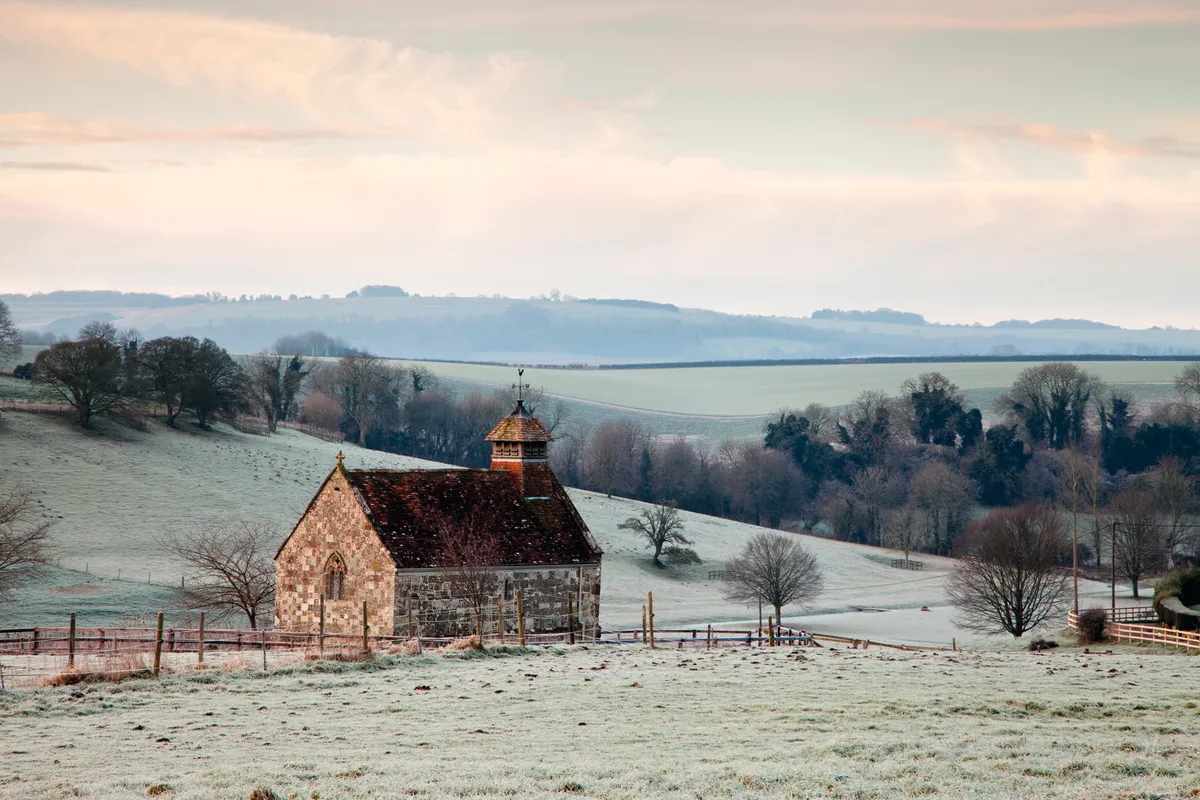
Where is Wiltshire?
Wiltshire is a fascinating and historic county in southern England.
Which prehistoric monument can be found in Wiltshire?
Most famously, the prehistoric Stonehenge site is in Wiltshire.
What is unique about the Wiltshire landscape?
In Wiltshire, what lies just below the surface – and its geological thin layer of soil, springy, herby turf and winter-bleached grass – is often visible. Its past and our links to the farmed land are as clear and present as bone under skin – or white horses cut into the chalk.
Almost half of Wiltshire is an Area of Outstanding Natural Beauty (AONB), with the Vale of Pewsey and the Marlborough Downs part of the North Wessex Downs AONB. Ancient chalk cart tracks that curve in great, whalebone arcs connect the county’s eight white-horse hill figures.
You may also like:
This is Ravilious country; it’s the country so atmospherically interpreted in the paintings of David Inshaw (b. 1943); and where you are never far from the area’s prehistoric farmers, particularly in winter. Round barrows (burial mounds) pock the landscape and long barrows loom like green-grey grass-roofed barns. The furrows and drill lines of modern farming form huge, measured, sweeps around these sites, as if someone has taken a wide curry comb to the land’s flanks and groomed carefully around its knots and whorls, so that, in the winter fields, they seem ever more prominent. An agrarian counterpoint to the elasticity of time.

What to do in Wiltshire
Best historic places to visit in Wiltshire
Stonehenge and the winter solstice
The winter solstice has always been important in Wiltshire, poignantly so for its first farmers, who longed for a sign that light, warmth and hope would return. Stonehenge on Salisbury Plain (simply ‘The Plain’ locally) is at the heart of a 6,500-acre World Heritage Site that includes lesser-known Avebury.
The winter solstice trumped the summer one at Stonehenge. The towering sarsen stones are aligned so the sun, at its lowest, almost still-point of the year, sets between the tallest ‘trilithons’ and appears to drop into the Altar Stone at the solsticial axis, like a great gold coin, turning the clock and cogs of the season back towards the light. The longest night of the year follows and the sun’s rebirth at dawn the next morning is celebrated, as from that point, the Earth begins to tilt back towards the sun and the days begin, incrementally, to lengthen.
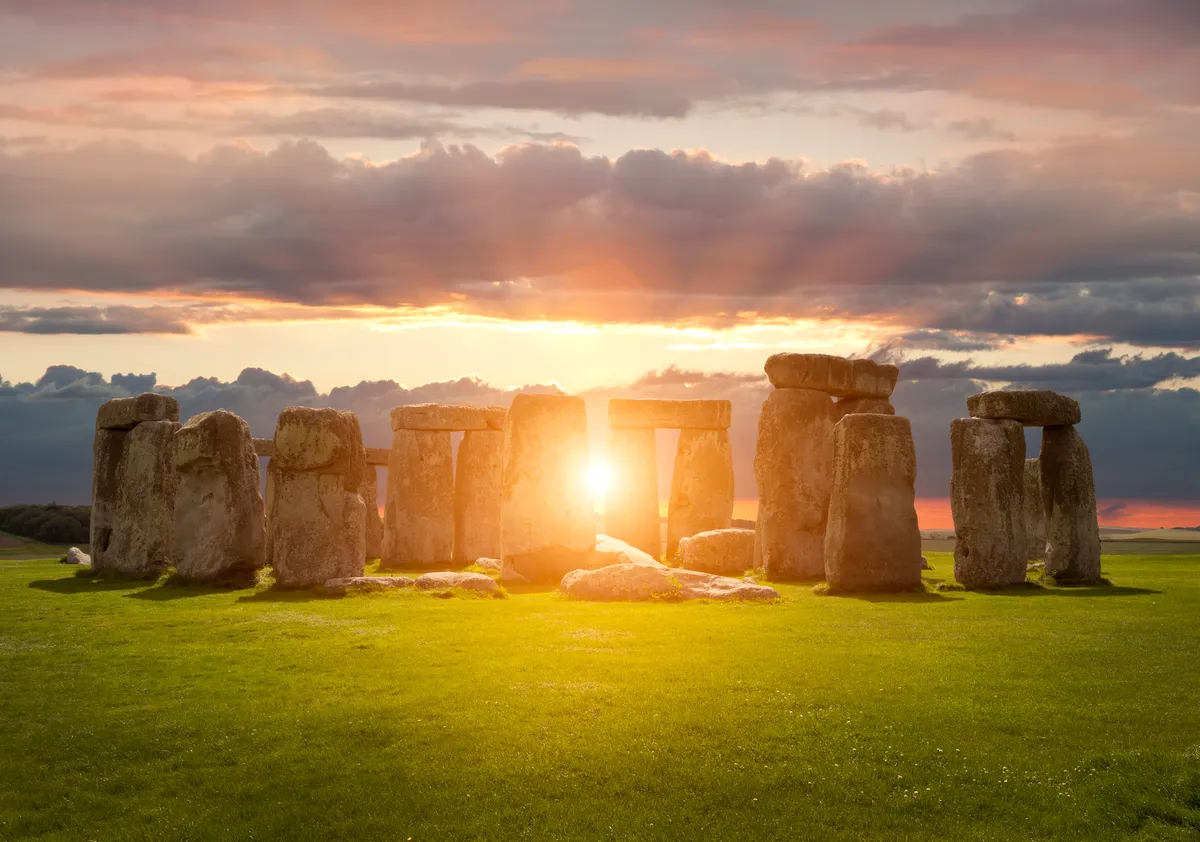
It’s a spine-tingling experience, to see people come from all directions as the sky begins to lighten, and walk towards the megaliths that dwarf them. And it is awe-inspiring to watch a midwinter sun rise through the monument on a cold winter dawn to whoops and cheers, and light the stones and people’s faces alike to a warm glow as it has done for thousands of years.
A brief history of Stonehenge
Stonehenge is one of the most recognisable and fascinating monuments in the world; this status was confirmed when it was named a World Heritage Site in 1986. Spiritual wonder surrounds the improbably-constructed 5,000-year-old stone circle, which is considered the most architecturally sophisticated of its kind in the world.
Stonehenge comprises the unique use of two different kinds of stones – bluestones and sarsens – the largest weighing over 40 tonnes, thought to have travelled as far as 140 miles from the Preseli Hills in Pembrokeshire. It was built in stages over approximately 1,400 years, starting as a ditch with wooden walls and posts in 3000BC until heavy stones were erected between 2400BC and 2200BC.
There are 83 stones in the circle in total: the larger sarsens, some of which weigh over 20 tonnes, and the smaller bluestones.
To test the feat in the modern day, at the turn of the millennium a group of volunteers attempted to move a bluestone from Wales to Wiltshire. But as the enormous bulk was being rowed across the Bristol Channel on two ancient replica boats, it slipped into the sea – so much for that plan.
Over the centuries, the area has been host to astronomical query and archaeological digs. The significance of the arrangement of these prehistoric megaliths is still pondered today.
A site of scientific interest
One of the most popular theories about Stonehenge is that it was an ancient observatory or a scientific instrument for accurately measuring the rising and setting positions of the sun, moon, planets and stars.
Skeletal remains dating back as far as 3000BC have also been found during archaeological digs. One of the most famous was deemed the Stonehenge King by the press, because of the treasures buried with him; gold hair ornaments that are thought to be the earliest gold objects found in Britain.
One of the first people to scientifically examine the site was John Aubrey in 1666, whose excavations pits still bear his name. He was the first person to associate it with druids.
In 1798, local merchant William Cunnington began excavating a large part of the land surrounding the stones – several hundred barrows – and he unearthed wood, animal bones and pottery.
Laser scanning is one of the more recent approaches to answering the mysteries of the henge. In 2011, scientists carried out a laser survey in the hope to uncover information that is invisible to the naked eye.
The evidence has shed light on the intricate way some of the stones were hand-carved with axes so that they would glint in the sunlight from certain approaches.
A mystical visit
Stonehenge is open to visitors on most days of the year, with English Heritage guides talking you through its history. The privilege of walking amid the stones and considering the true meaning of this ancient, dramatic creation is well worth the trip.
In recent years, it has become tradition for modern day druids, pagans and revellers to camp near Stonehenge for the spring, summer, autumn and winter solstice. The most popular of these is the summer solstice, when around 30,000 people descend upon the monument, which is open overnight free of charge. Dancing, music, prayer and storytelling feature strongly as part of the tradition.
Ancient ways
The old theory that the site was a sanctuary for worship of the sun, although not unanimously agreed by historians, is nevertheless illustrated by the yearly Midsummer’s Day ceremony, during which there is a folkloric procession of bards and druids at Stonehenge.
In fact, Stonehenge is the subject of many theories, including being a site of pilgrimage or even burial.
Led by the senior Druid, the simple pagan celebration becomes a broad, spiritual and personal one, with everyone welcome, singing, dancing, drumming or just being still and together. Whether the energy comes off the people, the warmth, the dawn-lit stones, or a combination of it all, it is life-affirming in its simplicity and spiritualism at a time of year when we seem otherwise to be doing the opposite.
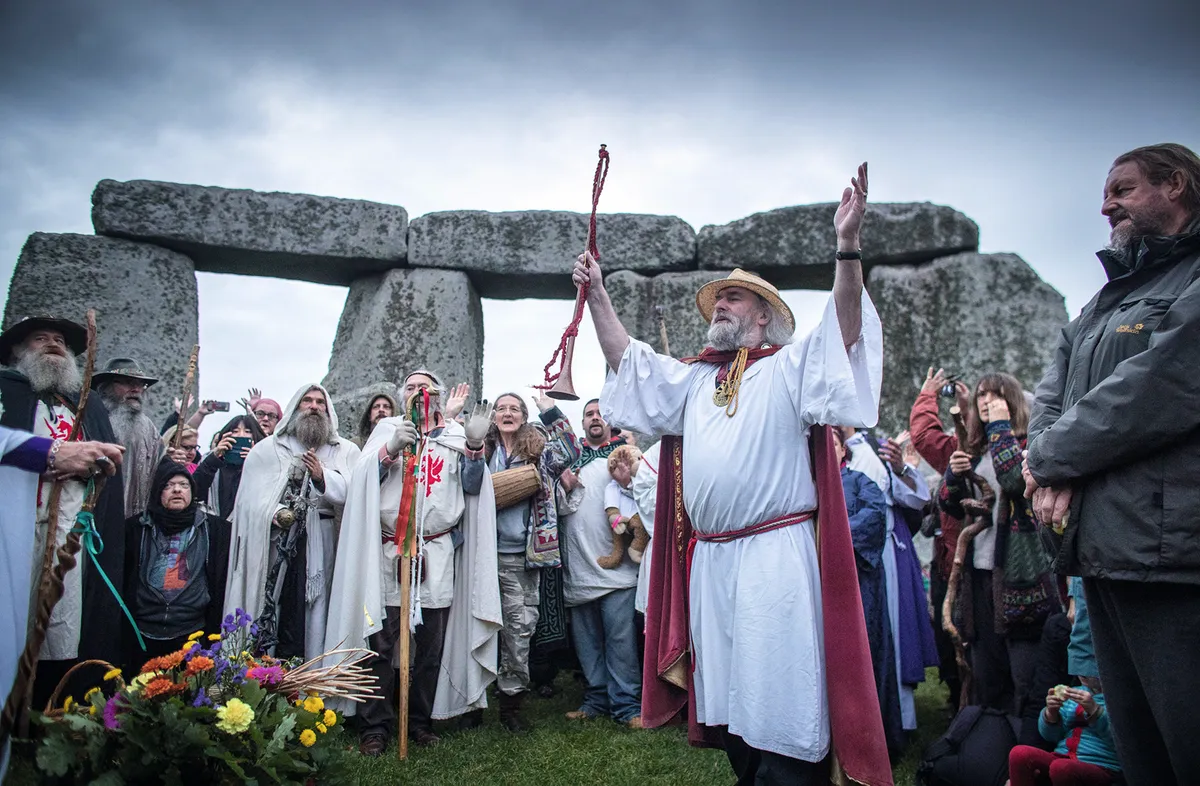
Avebury, Silbury Hill and Kennet Long Barrow
Avebury, with its odd, manmade humps and bumps in such a smooth and rolling landscape, has an altogether different atmosphere: a still-sacred air, balanced with fond, wry irreverence that makes Stonehenge seem austere. Perhaps it is because a whole village has been built half-in, half-out of the enormous stone circles, paying no heed to its boundaries. Over time, the stones have been broken-up, buried or incorporated in situ into the walls of houses. Revered, feared, used and now loved, there is something personable about each one.
This extraordinary landscape includes Silbury Hill, Wiltshire’s prehistoric chalk and turf ‘pyramid’, built by Neolithic people and the largest manmade hill in Europe. Conical, with a (possibly uncontemporary) flat top, it remains a commanding and mysterious presence, stolidly keeping its 4,700-year-old authority to itself.
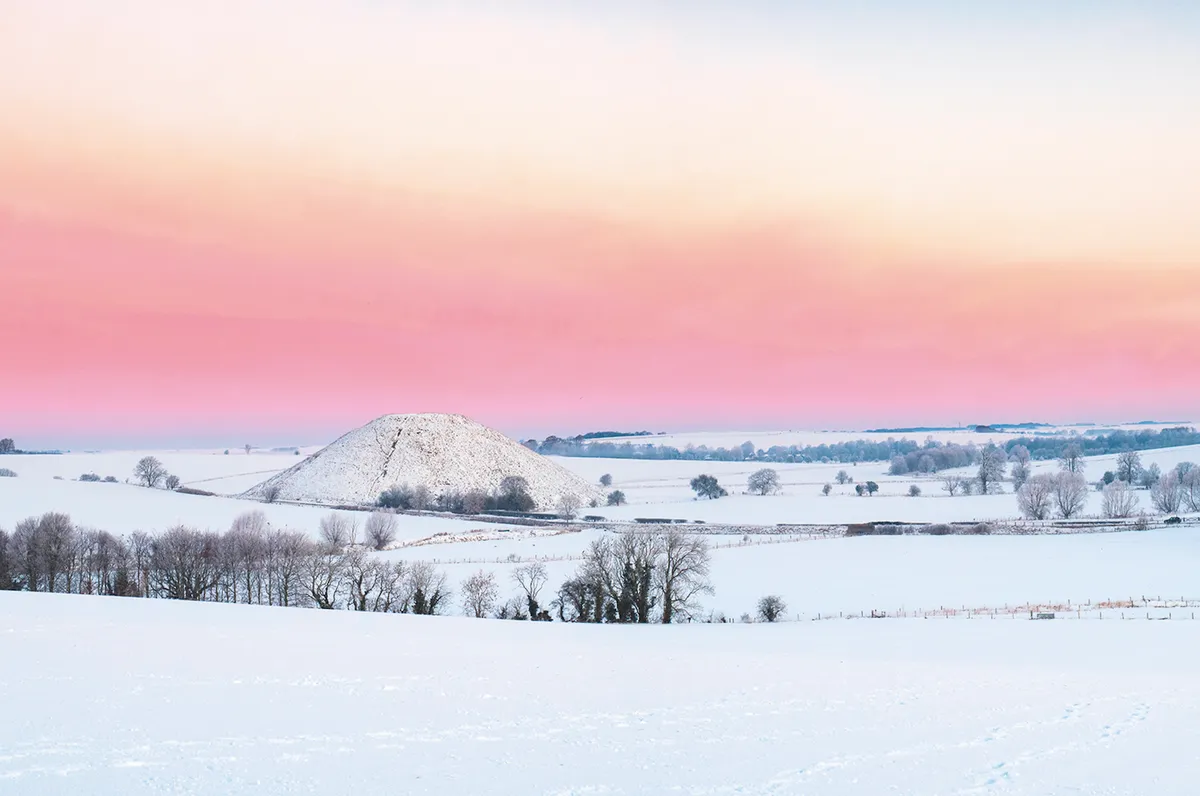
A short walk across the A4 takes in West Kennet Long Barrow, where you can walk right into the soft darkness of the former burial chamber. A frost or snowfall puts this place under a deeper magic spell, with a vision of how the once-bare, white-chalk monuments would have gleamed under the winter sun or in full moonlight.
Savernake Forest
From the heights, scarves of milky-white mist ribbon the winterbournes in the valleys of Pewsey Vale, obscuring all but church towers. On the more bitter days, take to sheltered routes where you will find villages with thatched cob walls and ancient woodlands such as Savernake (where Jane Seymour, Henry VIII’s third wife, was born at Wolfhall).
Savernake’s ancient oaks are named and legendary. The Big Belly Oak, the King of Limbs, the Duke’s Vaunt and others look suitably dramatic, when the undergrowth is pared back. Nearby is West Woods, where – it was discovered only this year – Stonehenge’s sarsens came from. In the nearby hamlets of Fyfield and Piggledene, ‘rivers’ of stones scatter among the thatched cob cottages. Known locally as ‘grey wethers’ (sheep), they would fool the wisest shepherd on a foggy day.
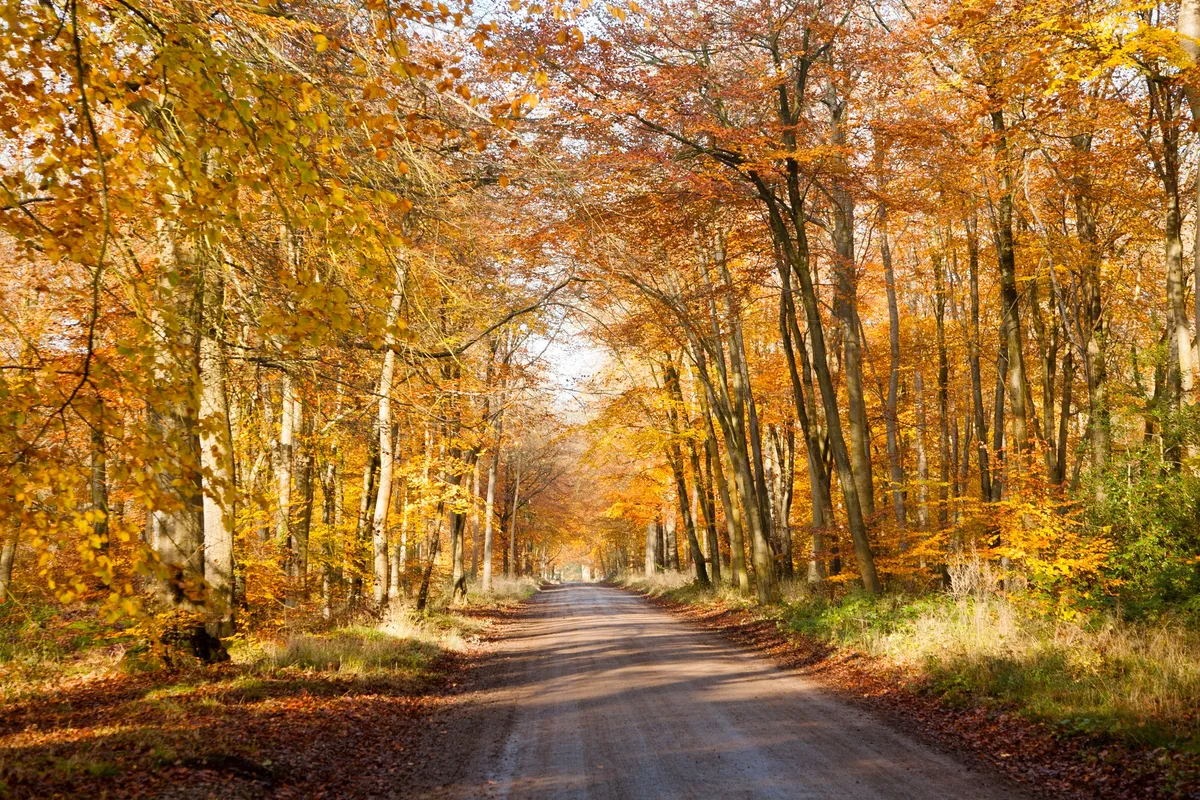
Great Bedwyn
Descend into the village of Great Bedwyn, where wreathes of wild clematis wind through every hedgerow on the chalk. Old man’s beard, woodbine, traveller’s joy or ‘Father Christmas’, this much-loved plant comes into its own here at this time of year. Its local name is ‘bedwine’ – perhaps a corruption of ‘betwined’ or ‘between’ or bedwyn itself, for ‘bedw’, is the Celtic word for grave or bed and ‘gwyn’ for white. In this land of once-white graves, it seems appropriate. The feathery seedheads have a shifting, magical beauty of their own, glowing like fairy lights in the late afternoon sun and disappearing entirely on wet days.

Castle Combe
With its soft, golden Cotswold stone weavers’ cottages, medieval church and packhorse bridge, Castle Combe demonstrates all the credentials needed to play the quintessential sleepy English village in many films and TV series – from Dr Doolittle, Dick Turpin and Robin of Sherwood to the 2007 fantasy adventure film Stardust.
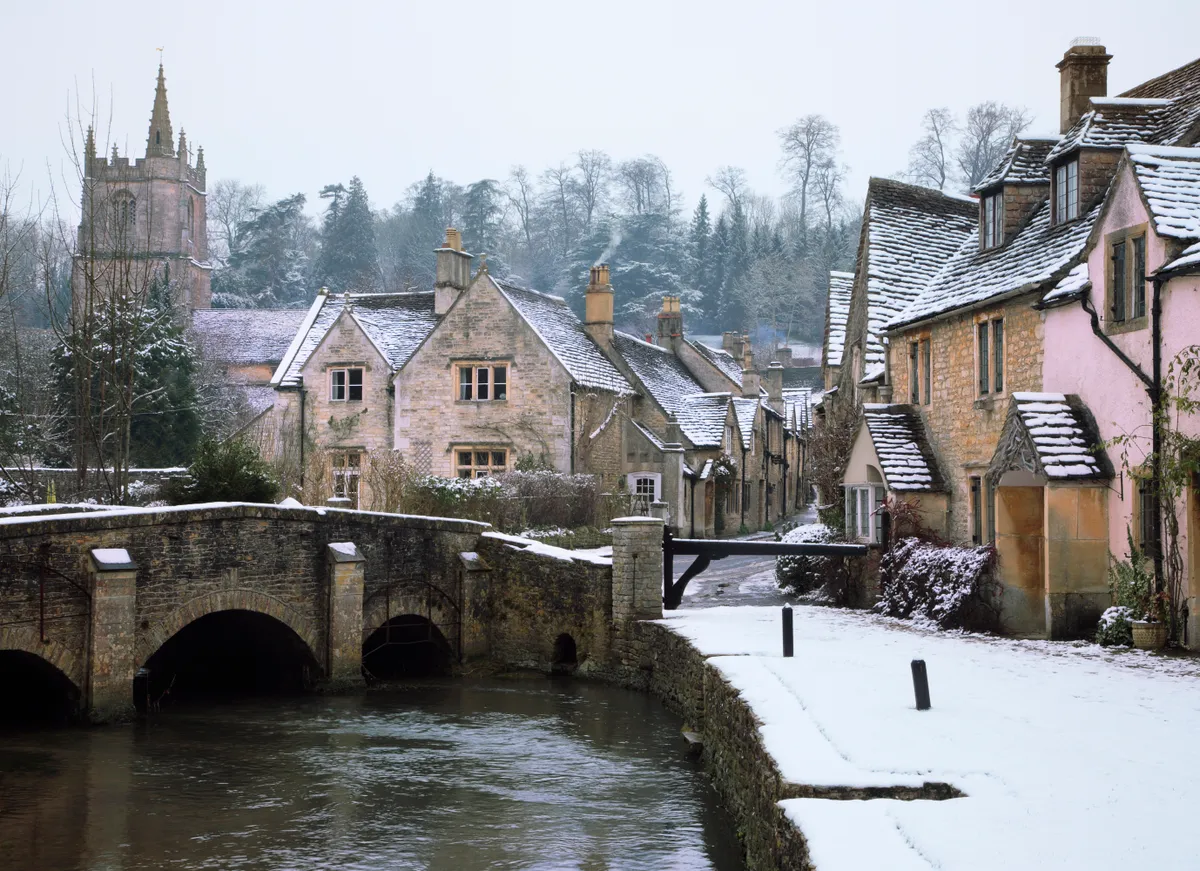
Lacock or Avebury villages
Step back in time in the villages of Lacock or Avebury to find thatched threshing or tithe barns like rural cathedrals and pubs with roaring fires, ghost stories, mulled wine and spiced mead.
Wiltshire is a wonderfully evocative, sensual, slightly haunted county but a comfortable, peaceful one, too. There is a lyrical poignancy in its winter landscape. And it’s fun to reflect on those old, old pagan customs still present in our modern Christmas celebrations, with their long connection to nature and the farming year. What better than all that deep time, space and spirituality to reflect on at this most still-point of the year, in these most strange and still times?
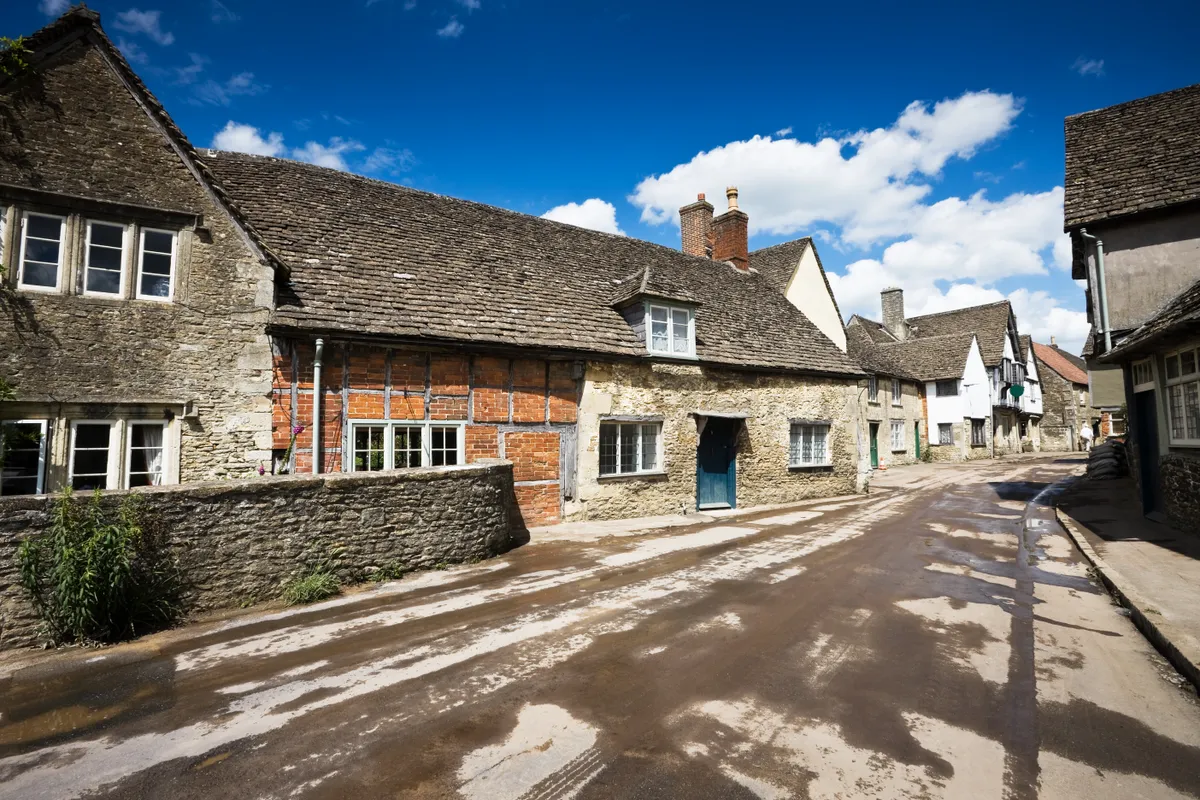
Devizes and the Wiltshire Museum
Midway between Stonehenge and Avebury, in the cosy market town of Devizes (or Vizes, to locals) with its 500 listed buildings, is the award-winning Wiltshire Museum, which features ancient gold and goggles worn by sarsen knappers between 1850 and 1939. Thurs–Sat, 10–4.
Caen Hill Locks
The 29 locks of the Caen Hill Locks on the Kennet and Avon Canal are worth braving the weather for. They are built to cope with a rise of 72m in 3.2km (237ft in two miles) and the middle 16 locks are a scheduled monument. It takes six hours to complete it in a boat.
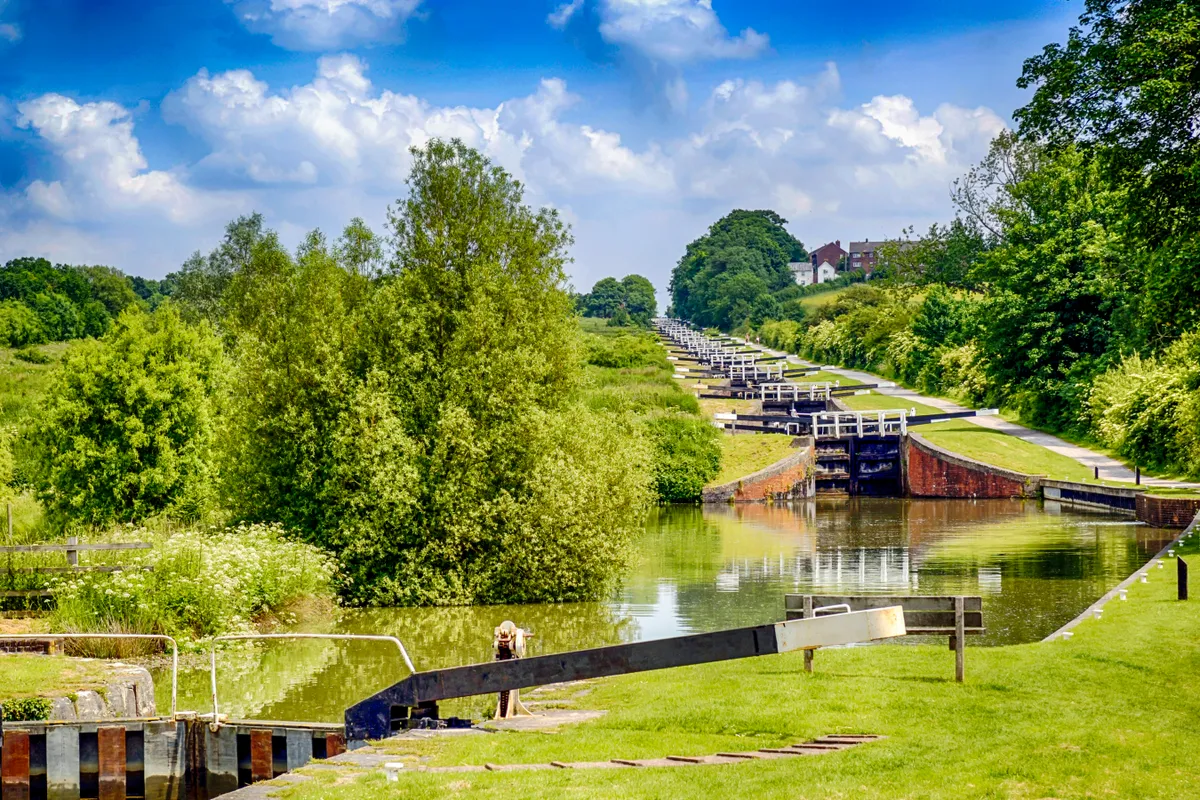
Wadworth Brewery
Warm up with a visit to the imposing red brick Victorian Wadworth Brewery. There you’ll find a unique collection of hand-painted pub signs, a tour of the ‘Brewseum’ (Covid19 permitting) or a chance to sample beer in the toasty Harness Room. Wadworth still use a dray and pairs of magnificent shire horses to deliver beer locally.
Best walks in Wiltshire
Long-distance walks
Wiltshire has a wealth of walks and tracks, including several long-distance trails. On the other side of the heights of Pewsey Vale, a dewpond forms the hub of 10 footpaths, emanating like spokes. The names are a litany of drovers tracks – Workway and Wansdyke, White Horse and West Way – for those who would have stopped and broken the ice on the pond to water their animals.
The Great West Way links Bristol to London through Wiltshire, and Britain’s oldest ‘road’, the Ridgeway, begins in Avebury. King Alfred’s Way (opened this year) takes in Wiltshire’s part of the former kingdom of Wessex in a 220-mile off-road trail, and the 90-mile White Horse Trail invites you to ‘collect’ all eight horses (a ninth, the oldest horse at Uffington, is just over the border in Oxfordshire).
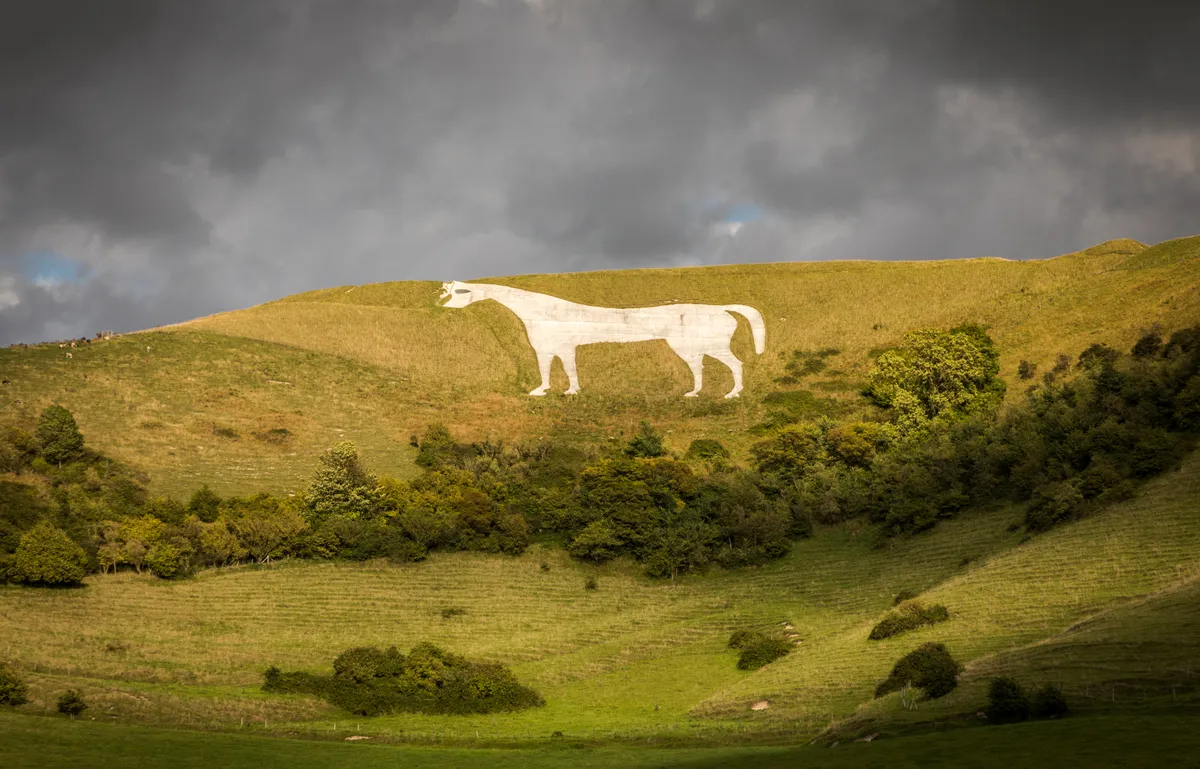
Bedwyn Brail
A circular walk from the lovely village of Great Bedwyn, featuring rural beam engines, working windmills, canals, houseboats, woodland and fields. Can be muddy but relatively easy walking on tracks and towpaths and the chance of a warm up in the village; 5.5 miles.
Barrows and Stones
This circular walk from Avebury’s farmstead steadily climbs to the Neolithic meeting place of Windmill Hill. Its striking panorama takes in the Ridgeway, Avebury Henge, Silbury Hill, Milk Hill (Wiltshire’s highest point) and Cherhill Down with its white horse, hill fort and obelisk; 2.5 miles.
Wessex Heights, Vale of Pewsey
For a stunning view of Ravilious country, park at the foot of Knap Hill and climb it. Follow the ridge line to Gopher Wood where the Tan Hill Way joins the White Horse Trail, skirting the vanished village of Shaw. Follow the bridlepath to the Wansdyke and the byway back. The Alton Barnes White Horse is a short detour. OS 157 Marlborough and Savernake map recommended!
Best wildlife to see in Wiltshire
You’re never far from ‘a gallops’ in this land of the horse, or a string of fresh thoroughbreds, snorting dragon-clouds of steam through flared nostrils on a chilly morning, striped Witney blankets rippling over their loins. Even the hilltop beech hangars look clipped into giant steeplechase fences.
Above the hoar-frosted cartwheels of hogweed seedheads, you may spot the white-and-wheat-stubble ghost of a barn owl hunting in the golden hour of the short days, or short-eared owls, late afternoon, quartering. Skylarks still sing from a height on winter days and linnets, yellowhammers and corn buntings raid the wild-bird-cover strips grown for them by the combined efforts of local farm clusters.

Places to stay in Wiltshire
The Sign of the Angel, Lacock
With beams, flagstones, panelled rooms, a friendly ghost and huge roaring fires, 15th-century Sign of the Angel is a winter’s treat. Located in the picturesque National Trust village of Lacock, the inn offers great local food from the farming brothers who run it. Double room from £110.
Rollestone Manor
This Grade II-listed house on Salisbury Plain dates to 1242, is close to Stonehenge and surrounded by tumuli. Lady Harriet’s Room at the Rollestone Manor has views out to the village church, and the Cardigan has a cosy four-poster bed. Double room from £95.
The Pear Tree Inn, Melksham
The mullioned bedroom windows of this cosy 17th-century farmhouse look out over the pear orchard varieties after which its rooms are named. Expect local fare and Stonehenge Ales around the woodburning stove at the Pear Tree Inn. Double room from £125.
Bowood House Hotel and Spa, Calne
Elegantly designed, contemporary rooms at Bowoow House have been influenced by the heritage colours and history of this grand estate, by the Marchioness of Lansdowne. Choose from rooms with balconies, views over Capability Brown parkland, or the entire floor of a tower. Double room from £140.
Where to eat in Wiltshire
The Polly Tea Rooms, Marlborough
Founded in 1912 by a suffragette and her partner, The Polly is much-loved locally. Famous for its breakfasts and legendary cake table (baked on site), it was a favourite of Sir John Betjeman and the teenage Duchess of Cambridge.
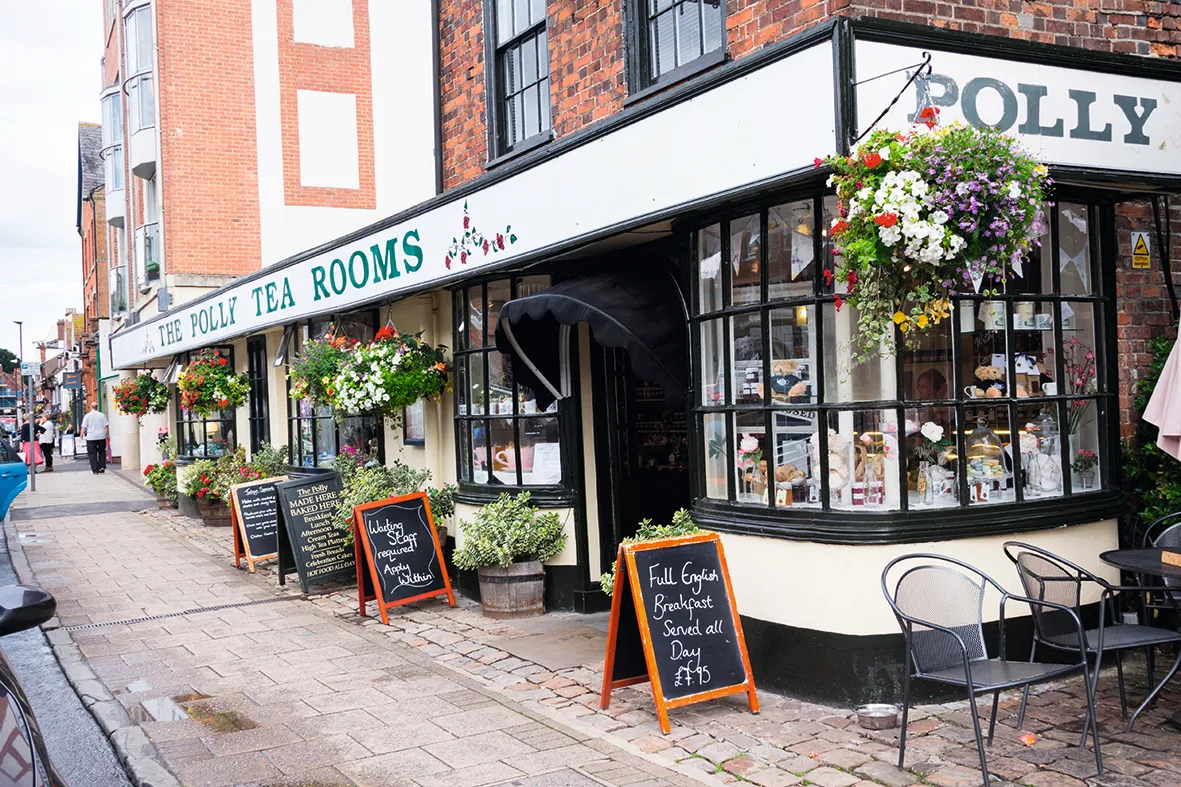
Honeystreet Mill, Honeystreet
Mother and son duo have created a warm, welcoming, contemporary café on the banks of the Kennet and Avon Canal. At Honeystreet Mill you’ll also find handmade Fairtrade gifts for Christmas, a historic boatyard, a real flavour of Wiltshire and plenty of local history.
Pewsey Vale Community Craft and Tea Room
A delightful stop on the banks of the River Avon in Pewsey. Run by friendly volunteers, Pewsey Vale Community Craft and Tea Room is a great place to shelter and get the local low down as well as a steaming mug of tea and delicious cake. Wonderful local crafts on sale too.
Winter lights in Wiltshire
Stourhead
Wander through the illuminated gardens of Stourhead’s beautiful landscape, with festive music, glittering trees, a crocus lawn and a scented fire garden. 27 November–3 January.
Salisbury
Salisbury is usually a festival of light at Christmas, with a magical start to Advent (29 November–1 December). The Darkness to Light procession begins with a single flame in the medieval cathedral and processes to 1,300 flickering lights.
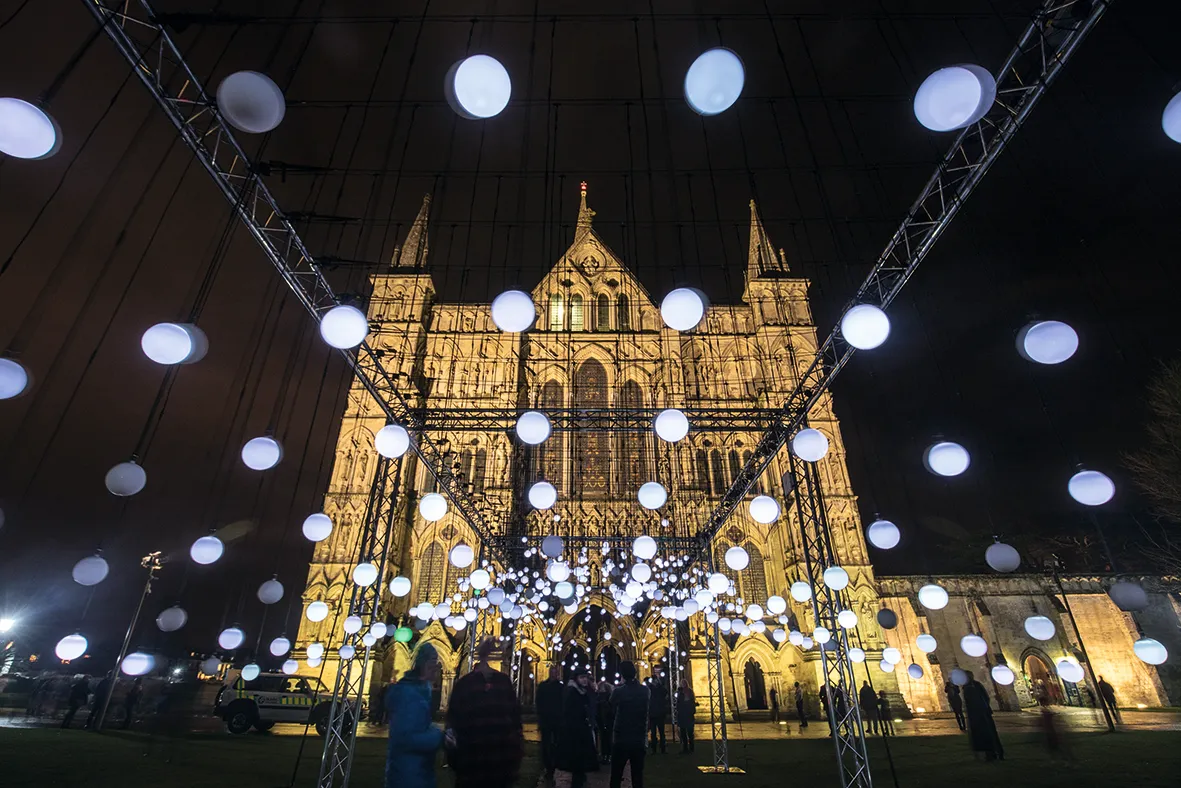
Geminid Meteor Shower
Geminid Meteor Shower (mid December) sees shooting stars fall in beautiful bauble colours. Much of Wiltshire is a designated Dark Night Sky Reserve. Wrap up warm, take a torch and a flask of something hot and head for a wide open dark spot. Binoculars will bring the stars closer! You’ll need 20 minutes of complete darkness to allow your eyes to adjust.
Words: Nicola Chester
